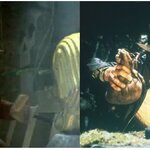Archaeology

One time, I was on vacation with my parents and we went to some garden. Oh man, I hate gardens. But that's not the point. The point is that the garden had some alpacas just hanging out, and this groundskeeper with a pleasant Maritimer accent, comes over and explains how tame they are and how soft they feel when you shave them. And he was right, alpacas are awesome. These things are super cute, but the question is where did they come from? They're domesticated animals. What is a domesticated animal? Well, it's an animal th

2008 excavations at Hohle Fels Cave in the Swabian Jura of southwestern Germany recovered a female figurine carved from mammoth ivory from the basal Aurignacian deposit. The figurine is the earliest depiction of a human and one of the oldest known examples of figurative art worldwide and is at least 35,000 years old.
If you're looking closely at the Venus of Hohle Fels below, you may also notice those are breasts, which radically changes our views of the context and meaning of the earliest Paleolithic art; maybe it's porn-eolithic.
The Venus of Hohle Fels. Foto: H. Jensen. Credit: H. Jensen,…

The oldest submerged town in the world is about to give up its secrets — with the help of equipment that could revolutionise underwater archaeology.
The ancient town of Pavlopetri lies in three to four metres of water just off the coast of southern Laconia in Greece. The ruins date from at least 2800 BC through to intact buildings, courtyards, streets, chamber tombs and some thirty-seven cist graves which are thought to belong to the Mycenaean period (c.1680-1180 BC). This Bronze Age phase of Greece provides the historical setting for much Ancient Greek literature and myth, including Homer’s…

A recent find has archaeologists and pet-lovers equally excited. How much do you love your little Fido? Enough to wrap him in linen and take him with you? I'm not thinking summer vacation here but something more along the lines of Valhalla. That is exactly what happened to an Egyptian puppy some 2,300 years ago.
As an Egyptian tomb was excavated recently, an "awe" arose due to its cuddly find. Hapi-Puppy, a 2,300 year old mummified pet met his end when his owner "Hapi-Men" passed away. Many Egyptian tombs contain cats, birds and baboons to accompany their masters…
Kidding, Fresh Kokanee: The Pathways of Salmon just seemed so bland. Just testing out a wee hypothesis. Human with an opposable thumb and all that? Still reading this? Good.
Thanks for that commercial break. And now back to Kokanee.
Salmon have permeated First Nations mythology and have been prized as an important food source for thousands of years. For the Salish people of the Interior, salmon was the most important of the local fish and salmon fishing season was a significant social event which warranted the nomination of a “Salmon Chief” who directed the construction of the…

There is beauty in strange places. Think of the perfection of the shell midden, a pile of garbage that now holds interest for those who study archaeology (since garbology didn't sound as sexy).
The garbage label holds especially true when we look at the shell middens from ancient beach sites. Having food “packaging” accumulate in vast heaps around towns and villages is hardly a modern phenomenon. Many First Nations sites were inhabited continually for centuries. The discarded shells and scraps of bone from their food formed enormous mounds called middens. Left over time,…

A trove of Benjamin Franklin letters has turned up in the British Library. Discovered by University of California, San Diego professor Alan Houston, the letters are copies of correspondence that hasn't been seen in more than 250 years.
All dating from the spring and summer of 1755, the 47 letters by, to and about Franklin are in the hand of one Thomas Birch, a contemporary of Franklin's who was a prodigious – almost inveterate – compiler and transcriber of historical documents. They are being published for the first time in the April issue of the William and Mary Quarterly.…

A project supported by the Austrian Science Fund FWF wants to uncover the history, significance and precise origins of Islamic art contained in Viennese art collections; comprehensive work to reconstruct the background of several Ottoman flags has already been carried out with impressive results.
Traces of the era of the Turkish wars - such as the tradition of the Vienna coffee house and the Ring boulevard that encircles the city centre - are still evident today in the day-to-day culture and street layout of the Austrian capital. The Turkish sieges of Vienna (16th/17th century) led to an…

If Van Helsing were poking around Transylvania these days, chances are he'd be more likely to be looking for the decaying remains of 35,000 year old humans than blood drinking vampires. Romania's dark history extends back way past the days of Vlad. It seems vampires and ghouls aside, something darker and much more interesting lurks in that eastern belly. I travelled to Transylvania last year and spent some time in Cluj, the newly minted anthro-capital of Romania. I was lucky enough to brush shoulders and prep tools with paleoanthropologists working on a new…

Until a few months ago, the only connection that I was aware of between archaeology and Lego was the fact that I like both of them. But apparently other people do too.
I recently played the Lego: Indiana Jones game for Wii. The point of the game is to re-enact all three classic Indiana Jones movies (please, the Crystal Skull belongs in the same place as the Star Wars episodes 1-3: in a galaxy far, far away, or in a tomb deep underground where no one can see them). Playing Lego Indiana Jones with a bunch of archaeologists is even more fun than watching the movies with a bunch of…